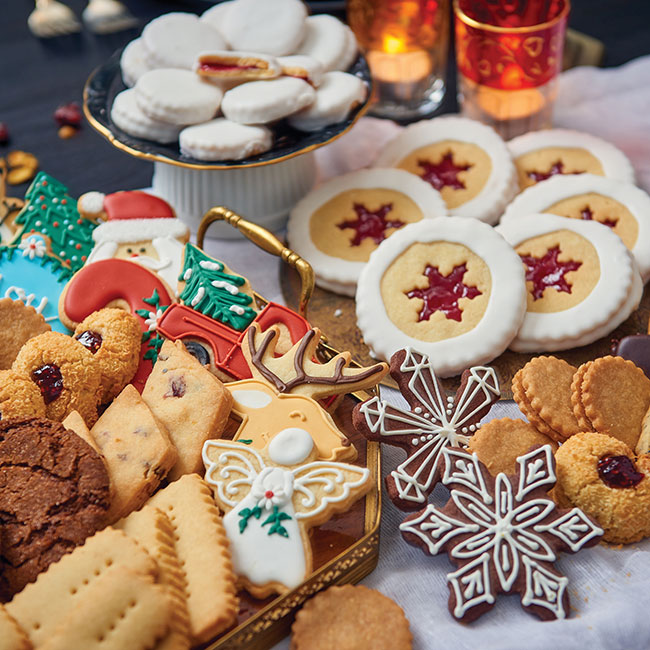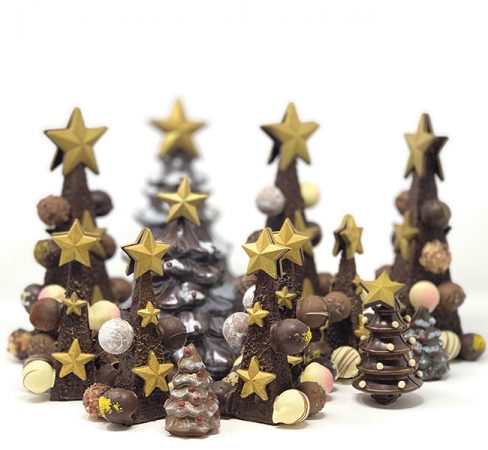
Visions of Sugar Plums
November 19, 2020
By Karen Barr
Carrying on Festive Baking Traditions
 The Imperial Cookie (white rimmed with red snowflake) is a purely Canadian invention from Winnipeg.
The Imperial Cookie (white rimmed with red snowflake) is a purely Canadian invention from Winnipeg. Pastry chefs and bakers bring joy to homes, especially during December. Classic, traditional baked goods that our grandparents may have enjoyed in their childhoods still remain, with a few twists along the way.
One treat synonymous with Christmas is the fruit cake. At Grandma’s Traditional Fruitcakes, in Red Deer, Alberta, Cynthia Baumgardt started what she thought would be a seasonal, home based business. The first year she considered herself successful when the local community purchased 200 of her fruit cakes. Today, 31 years later, Grandma’s Traditional Fruitcakes sells between 8000 to 10,000 per year.
“The recipe for the dark fruitcake is from my side of the family. The light fruitcake recipe is from my husband’s side,” Baumgardt says. Wrapped in shiny red foil, just like a gift, the dark fruit cake contains molasses, dark brown sugar, dark raisins, along with citrus peel and cherries, both green and red. “The spice blend is a secret,” she says. “The light fruit cake has pure vanilla extract, almond flavouring, golden raisins, citrus peel and cherries.” Customers can also choose to order cakes infused with a simple syrup, made with alcohol.
And what would a holiday gathering be without shortbread? Scottish born, Helen Buchan owns the thriving Mrs. MacGregor’s Shortbread in tiny Pictou, Nova Scotia, population 4000. Armed with her maternal grandmother’s shortbread recipe, she has built a thriving business, that proudly displays the MacGregor family tartan on the box, as well as a beaming photo of herself.
“The classic shortbread is the top seller. It outsells everything else. People love the buttery flavour,” says Buchan. “Number two is the maple shortbread. I make this by replacing the granulated sugar in the original shortbread recipe with maple sugar,” she reveals. Round out the number three spot is lavender lemon shortbread. In October, November, and December sales boom. “We sell as much in those three months, as we do the whole rest of the year.” In that fourth quarter, the little kitchen uses 800 pounds of butter to bake their shortbread.
Over at High Tea Bakery, in Winnipeg, Manitoba, the Imperial cookie reigns supreme. And, if the creation sounds like a classic cookie from Europe, well, guess again. “It a 100 per cent Winnipeg creation,” laughs owner Belinda Bigold, who in 2003, opened the business with her mother Carol.
Just what is the Imperial cookie? It’s an almond shortbread cookie, with a raspberry preserve filling and pure almond icing. It seems everyone from Queen Elizabeth to Bon Jovi have enjoyed it. Within the three to four weeks leading up to Christmas the bakery sells over 25000 of this variety of cookie alone.

Stubbe Chocolates bring European flair to edible centrepieces and treats.
High Tea Bakery offers a seasonal collection of cookies. Think eggnog cream cheese cookies, chocolate peppermint thumbprints, nutmeg logs and even a sticky toffee pudding cookie. Bigold is thrilled that even enthusiastic bakers choose to top up their dessert platters with purchases from her bakery every year.
The bakery’s hand decorated cookies are beautifully designed. “We have three collection each year: the Christmas collection, the Hanukah collection and the Snowflakes collection,” says Bigold. “Customers can choose from sugar cookies that are almost more like a butter cookie or a gingerbread cookie made with molasses.”
At Stubbe Chocolates, in Ottawa, Ontario, fifth generation German chocolatier Heinrich Stubbe takes the traditional gingerbread house and turn its into a 100 per cent chocolate masterpieces. Each is hand cut and crafted. Customers request personalized features, like their street number, outdoor light fixtures, and mailboxes resembling the ones at their own homes. So detailed are these chocolate creations that only three can be made per day.
“We have a high demand, and we want to make sure everyone is able to take home something special, so we also have molded chocolate homes. Each is hand painted and contains 10 truffles,” says Stubbe. The shop also makes chocolate Christmas trees. The center is a cone of chocolate, with an assortment of chocolate truffles around the outside, available with 40, 60 or 85 truffles.
Stollen, the German Christmas cake, is a seasonal favourite. Sales reach over 500 every year. The recipe was originally given to Stubbe, by his teacher, when he was a young apprentice in northern Germany. “Then, once I moved to Canada, I had to adapt it again, because the flours here are so different. So, it’s modified-traditional,” he concludes.
His stollen contains orange peel, almonds, and golden raisins, as opposed dark, so as not discolour the dough. This fruit and nut mix is marinated in rum and white wine, for 14 days.
Also, in Ottawa, pastry chef Elina Olefirenko, of Elina Patisserrie, recently designed the Mayan Treasure Christmas Cake, for Mercadito restaurant. “I wanted to create something both vegan and gluten-free, while incorporating ingredients from different regions of Mexico, like coffee, prunes, walnuts, and chocolate.” says Olefirenko.
Made from gluten free flour and glazed in chocolate, it’s topped with handmade dulce de papaya and caramelized orange zest. The result is a cake that is entirely original, yet looks like a jewel festooned Christmas classic.
Over in Montreal, pastry chef Patrice Demers at Patrice Patissier, gives the Bûche de Noël a contemporary spin. “We put mousse in a mold, then we insert a small cake into the center and another one on the bottom. This is frozen before being cut. This way we can add many textures.”
Customers can pre-order three types of Bûche de Noël. First, there is the ever-popular chocolate. “In the center of the dark chocolate mousse is an almond cake, with Amaretto chantilly. It’s made with Avril, an Amaretto made with Quebec maple syrup,” says the pastry chef.
Next, is the coffee hazelnut made with hazelnut praline mousse. A log of cake, is soaked in espresso and rolled, with milk chocolate and coffee chantilly, then placed inside the mousse. “At the bottom is a moist hazelnut cake, with crispy praline flavoured with coffee.”
This year’s creation blends white chocolate mousse infused with chai tea. Inside are two layers of a brown sugar cake, with an apple cranberry jelly in between. As a decorative element Demers says, “Sliced apples are gently poached in pure cranberry juice. We place them in the bottom of the mould before pouring in the mousse.”
Fruitcake, cookies of all kinds, chocolates, European specialties, twists on classics and new contemporary creations. Canadians can enjoy a sweet Christmas thanks to talented pastry chefs and bakers across the nation.
Karen Barr writes about arts, culture and cuisine. She is a graduate of George Brown College and is a Red Seal pastry chef.
Print this page
Leave a Reply